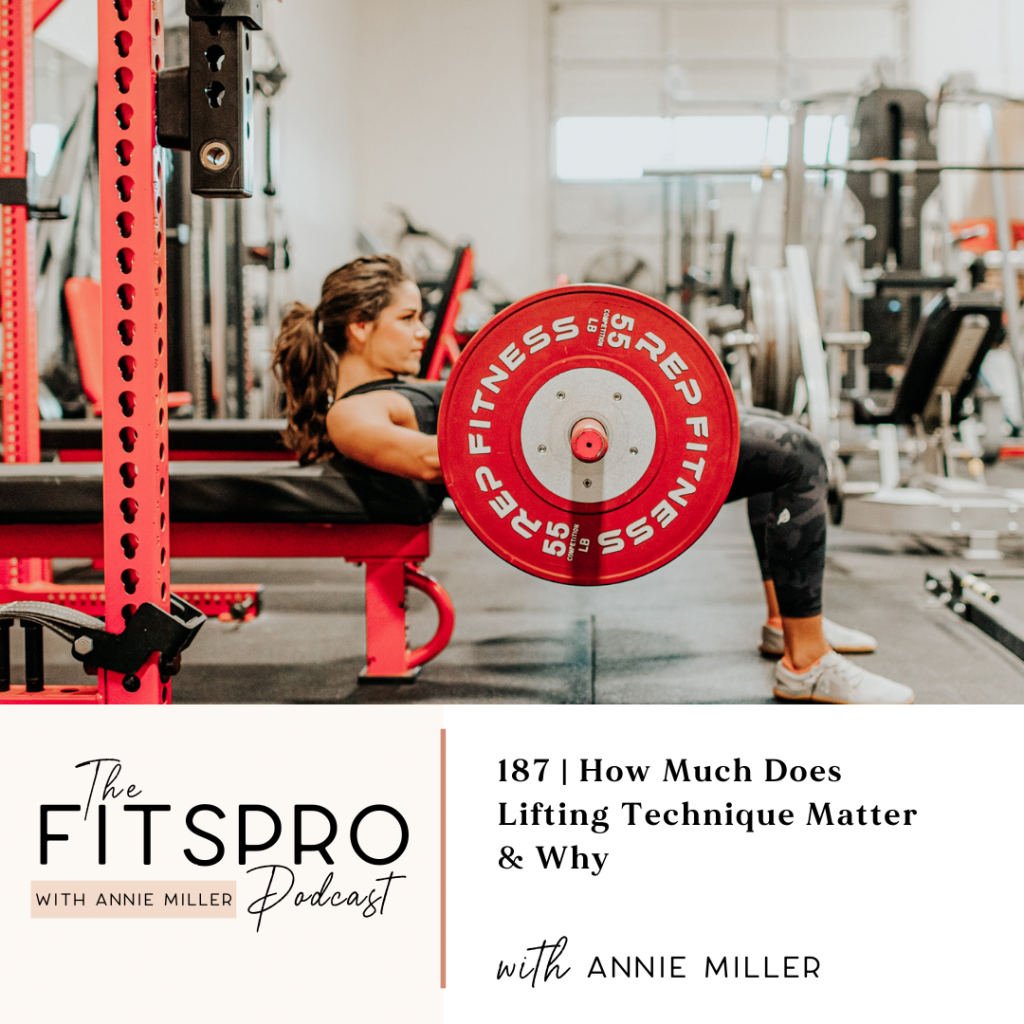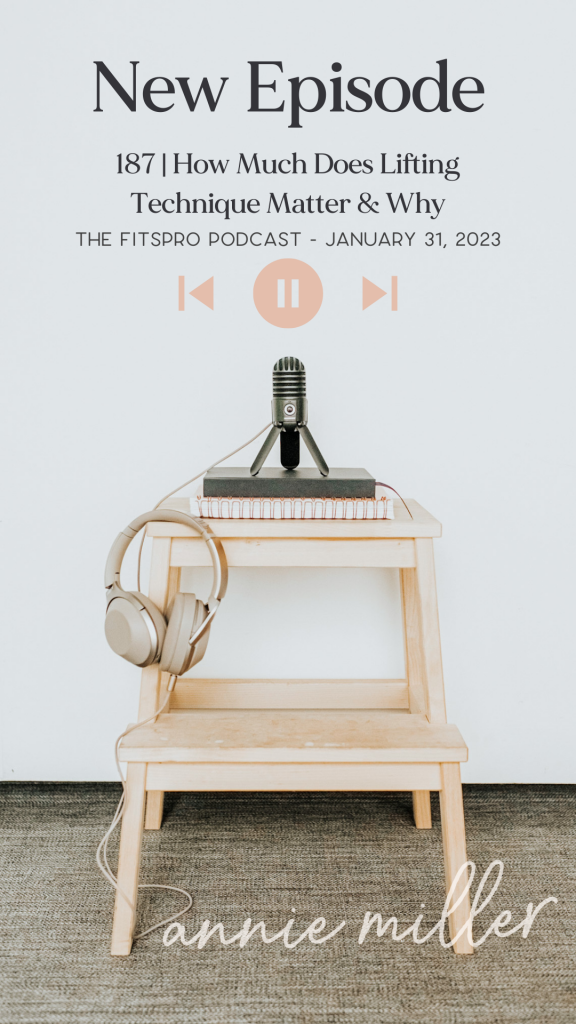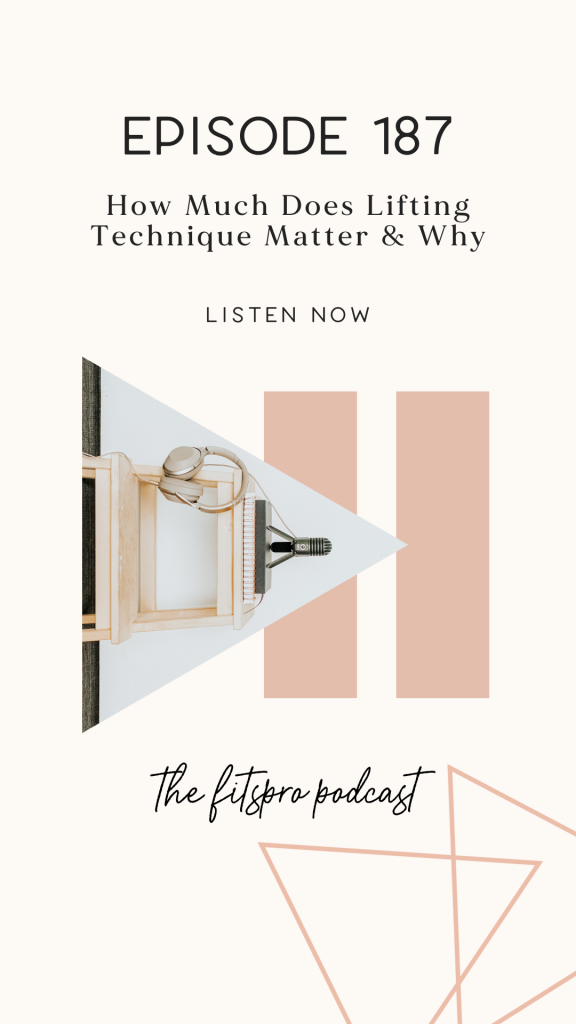the blog
welcome to
looking for something specific? find it here
Podcast: Play in new window | Download (Duration: 13:36 — 18.8MB)
Subscribe: Google Podcasts | RSS

I adore the topic of this episode. The idea of lifting technique is the literal reason I created Movement 101 in 2017 after rehabbing from a back injury that happened during squatting back in 2014-ish.
Now, I would be lying if I said that this back injury didn’t lead to me becoming a bit of a movement elitist. I’ve used this term before. And for me, it refers to this belief that one way to lift is the best way, that buffer zones are dangerous, and that pain is caused by bad movement patterns. It’s an aggressive and quite frankly tainted viewpoint. Which makes sense, because for me, it was formed in light of a pretty daunting injury.
This becomes a dangerous view because, one, it’s based in fear. It also doesn’t take into account bio individuality of the person who is performing the lifts. And it denies the truth that we can have perfect form and experience pain. And we can also have poor form and not experience pain. These things are not always dependent on one another. Lifting technique is not that black-and-white. So in today’s episode we are going to focus on some key principles that are very important within lifting technique and why they are important. Because there are certainly principles based in bio mechanics that are objective truths.
There are also pieces to training movement technique that lead to positive byproducts. And lifting technique is equally as important for those results.
While becoming a movement elitist is often based around fear or black-and-white thinking, there is definitely truth to the fact that positive lifting technique, or quality lifting technique does have a large safety component to it.
The safety that comes from quality lifting technique is often based in efficiency.
We want to generally move the body in the most efficient way possible, or the most mechanically advantageous way possible. Meaning that we are getting the most out of our movement patterns in the safest way that we can. And that’s really what lifting technique does.
It builds quality movement patterns. As a little caveat, I have had a conversation with one of my Physical Therapy friends and movement technique is important, but movement variety is also important. Because by drilling the same exact movement patterns over and over again, underload, for years or decades, we can actually end up limiting ourselves, and causing overuse injuries. That’s some thing that has come up for me personally in my training while I was pregnant. Before I was pregnant I started following the a TG program, and then during my pregnancy I transitioned into following the MamaSteFit prenatal program. And both of these exposed planes of movement and different types of rotation, or just different movement patterns that I had clearly neglected through programming for myself for almost 10 years. I say that because often times I think that when we talk about movement technique we veer towards the big lifts or the big movement patterns of squat, hinge, push, pull and carry. But all movement has technique involved, and quality technique is important for proficiency.
You’ve likely heard me talk about proficiency on other episodes in regard to building both larger muscle cells, and hypertrophy, as well as overall strength.
Having quality lifting technique and building repeatable neural pathways from your nervous system to the motor units that you are recruiting within each muscle fiber is going to be beneficial for putting on muscle and building strength. Strength is a skill, movement patterns are a skill, which is why having good lifting technique is going to be beneficial to you. From a safety standpoint, and from a muscle building or strength building standpoint.
Often times as the coaches and doctors at active life Rx would say, injuries don’t always come from poor technique, more often than not they come from load exceeding capacity. You did too much for what your body could handle. Perhaps, yes, that involved a rep or two with poor technique. But the poor technique was a result of too high of a load for your capacity. I’m not saying that always happens, but I do think that’s pretty common.
So load is a factor that is very important within the conversation of movement technique. We want to keep quality technique as we increase the load. That would be the safety component of this, as well as the efficiency that we’ve been talking about.
Some thing that is driven home inside my movement one oh one resource is the fact that we want to build quality movement patterns, technique, and awareness and then we can add load on top of those. But the priority is quality movement patterns, and becoming efficient and proficient in those, then adding the load. We should not be distracted by the load if we have not yet mastered the basic technique.
So what is quality technique?
Generally speaking, these are those principles that I mentioned in the beginning of the episode. Understanding foot contact with the floor, and spreading the toes pressing the whole foot into the floor, creating tension in the foot. Understanding how to find a neutral spine and brace in that position as well as learning how to brace in non-neutral positions. Because this will depend on the movement that you are performing. And we don’t want to become so rigid in the spine in a neutral position that we lose mobility and ability to brace 2° to 15° outside of that neutral position.
Generally understanding that mobility is going to be a big factor in most movement techniques. If you like the mobility to even get into the proper position you are going to compensate somewhere else.
For most barbell exercises or dumbbell exercises, the weight is going to want to be close to the midline for efficiency. Or over the center of the foot in the squat for instance. That might lead to a very different looking squat depending on someone’s limb ratios. Same goes for dead lift. Focus on the overall position, bar path, and where tension is being created, versus if a persons chest is at exactly 45° in a squat, or whether their shoulders are exactly an inch over the bar in the set up for a dead lift. That’s that bio individuality piece that can get lost with movement elitism.
A lack of quality movement technique isn’t probably going to make or break someone’s gains in the beginning, but overtime, as we add load, and that load likely exceeds someone’s capacity, the risk of injury definitely increases in my opinion.
So, for me, movement technique in general matters quite a bit. But is less black-and-white then maybe I used to consider it. It’s going to be the basis that someone builds their training adaptations on top of. And focusing on it has many benefits. When an athlete focuses on their weight training in a skill building manner, I think that it builds a lot more efficacy with their training. It feels good to have to put less effort into a movement pattern, or to feel more natural, or proficient with a given movement. That’s all gaining a skill is, and each lift within weightlifting, is a skill. Strength is an additional skill on top of that movement technique.
So in focusing on movement technique, we can form these foundations within training. Different levels of skills that can be built overtime, and then refined over time. Because bodies do change, and preferences change. But I guarantee if someone starts lifting and moving all willy-nilly, at some point they are going to have to revert back to reviewing, and rebuilding movement technique. So we can’t deny its importance. Especially in the long haul.
Again, that’s why the tagline for Movement 101 since 2017 has been move well, get strong. That is an essence my belief about movement technique.
Leave the FitsPRO Podcast a review


If you find value here, on The FitsPRO Podcast, then pretty please head over to iTunes, subscribe, rate and review the show. It means the world to me when you spread my message to more humans.
Want more podcasts? Click here to skim the archives.
P.S. Save this value packed episode for later over on Pinterest!
ALL THE LINKS YOU NEED:
Free On Demand Workshop: 3 Steps To Build a Profitable Online Health and Fitness Business
Supplements: Legion Athletics Code ANNIE for 20% off
Skincare: Fré Skincare Code FDBA for at least 15% off
Bags: Vooray Code ANNIE for 20% off
I'm an adventurous introvert from Vancouver, Washington who lives on sleep + "me time." I'm a lover of lifting weights, dinosaurs, real talk and traveling with my husband. I am here to help you move better, lift more, bust the myths of the fitness industry, and inspire you to love the process.
Hey you,
The name's Annie & you're reading my thoughts. Let's get acquainted.
the whole story >
looking for something specific? find it here
THE LINKS BELOW ARE AFFILIATE LINKS
SKIN CARE
Nutrition
brands I love
working against gravity
Fre skin care
favorites
blue light blockers
klassy network
code: fdba saves you 15% off
online TRAINERS
save $50
code: ANNIE saves you 20% off
You love my style, trust my reviews, and want more Annie Miller Concepts vibes in your life? Shop my favorite brands. You get awesome products and yours truly gets a little kick-back.
